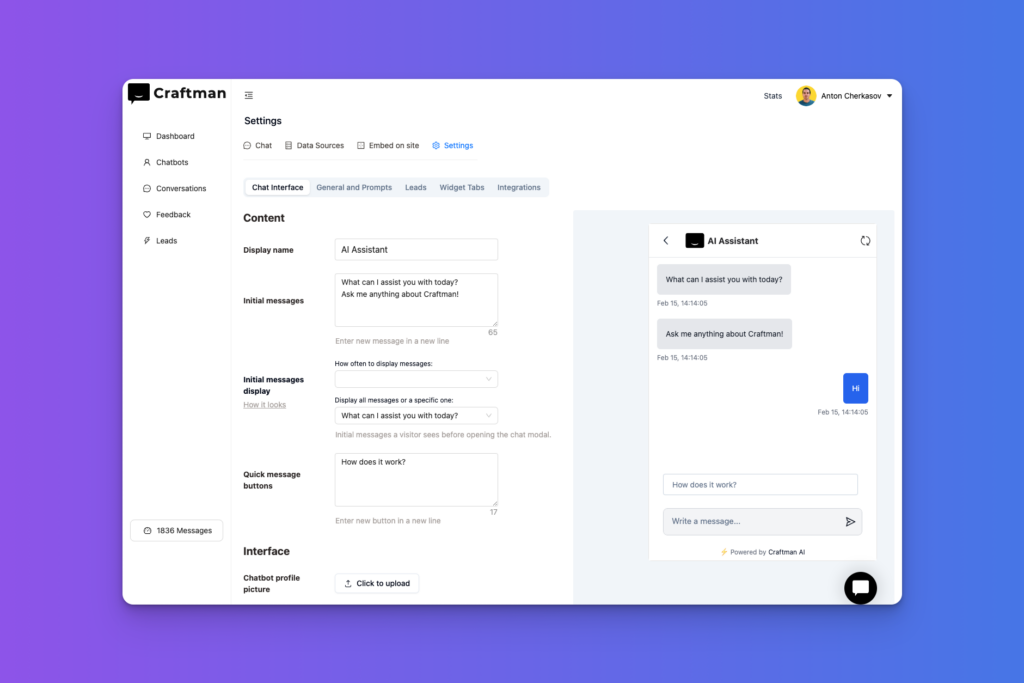What is an AI chatbot?
An AI chatbot is an automated software program that uses artificial intelligence to interact with users in a conversational manner. It is designed to understand natural language inputs and provide relevant responses or actions.
AI chatbots can be used for various purposes, including customer support, lead generation, and virtual assistants. They leverage technologies such as natural language processing and machine learning to continuously improve their performance and accuracy.
These chatbots can be integrated into SaaS platforms to provide efficient and personalized customer support, saving time and resources for businesses.
Benefits of using AI chatbots for SaaS customer support
AI chatbots offer several benefits for SaaS customer support.
Firstly, they provide 24/7 availability to assist customers at any time, reducing the need for human agents to be constantly available. Secondly, AI chatbots can handle a large volume of customer inquiries simultaneously, scaling the support system as the business grows.
Additionally, chatbots can improve response times by providing instant answers to frequently asked questions. They can also reduce human error by consistently providing accurate and up-to-date information.
Overall, AI chatbots enhance the customer support experience, increasing customer satisfaction and loyalty.
Key components of an AI chatbot
An AI chatbot consists of several key components that enable it to provide intelligent and personalized customer support. These components include:
- Natural Language Processing (NLP): This component allows the chatbot to understand and interpret user queries and responses in a human-like manner.
- Machine Learning (ML): ML algorithms enable the chatbot to learn from past interactions and improve its responses over time.
- Dialog Management: This component handles the flow of the conversation, ensuring a seamless and coherent interaction with the user.
- Integration Capabilities: AI chatbots need to be integrated with various SaaS platforms to access customer data and provide relevant information.
By combining these components, AI chatbots can effectively understand user intent, provide accurate responses, and deliver a personalized customer experience.
Designing an AI Chatbot
Defining the chatbot’s purpose and goals
Once you have a clear understanding of the chatbot’s purpose and goals, you can start designing its conversational flow. This involves creating a structured dialogue that guides users through different stages of the conversation.
User input is processed and analyzed using natural language processing algorithms to generate appropriate responses. It is important to consider the user experience and ensure that the chatbot is able to handle various types of user queries.
Additionally, the chatbot’s personality and tone should align with the brand image and values. By defining the chatbot’s purpose and goals, you lay the foundation for a successful and effective AI chatbot.
Creating a conversational flow
Once the purpose and goals of the AI chatbot have been defined, the next step is to create a conversational flow. This involves designing the sequence of interactions between the chatbot and the user, ensuring a smooth and intuitive conversation.
The conversational flow can be visualized as a decision tree or a flowchart, outlining the different paths the chatbot can take based on user inputs. It is important to consider various scenarios and edge cases to provide a seamless user experience.
Additionally, incorporating natural language processing capabilities allows the chatbot to understand and respond to user queries more effectively. By designing a well-structured conversational flow, SaaS businesses can enhance customer support and streamline interactions with their users.
Designing the user interface
Once the conversational flow of the chatbot has been defined, the next step is to design the user interface.
The user interface plays a crucial role in providing a seamless and intuitive experience for users interacting with the chatbot. It should be designed to be visually appealing, easy to navigate, and responsive across different devices. Additionally, the user interface should incorporate elements such as buttons, menus, and text inputs to enable users to interact with the chatbot effectively.
Designing a user-friendly interface will enhance the overall user experience and increase customer satisfaction.
Developing an AI Chatbot
Choosing the right platform and tools
When it comes to choosing the right platform for building an AI chatbot, there are several factors to consider.
First, you need to determine the level of customization and flexibility you require. Some platforms offer pre-built templates and drag-and-drop interfaces, while others provide more advanced options for customization. Additionally, it’s important to evaluate the platform’s integration capabilities with your existing SaaS platforms. Look for tools that can seamlessly integrate with your CRM, ticketing system, and other customer support tools. Lastly, consider the scalability and performance of the platform, as well as the level of support and documentation provided by the vendor.
By carefully considering these factors, you can ensure that you choose the right platform and tools to build an AI chatbot that meets your specific needs.

Craftman makes it super easy to build an AI chatbot in just 3 minutes, even if you’re not a tech expert. It’s really easy to train the AI with your own info, so it talks and helps your customers just the way you want. Plus, it grows with your business and helps you chat with your customers in a cool way.
Training the chatbot with relevant data
Training an AI chatbot with relevant data is crucial for its success.
The chatbot needs to understand the context and nuances of customer queries to provide accurate and helpful responses. This involves feeding the chatbot with a diverse range of data, including past customer interactions, product information, and frequently asked questions. Additionally, natural language processing techniques can be used to train the chatbot to understand and respond to different types of customer queries. By continuously updating and refining the training data, the chatbot can improve its accuracy and effectiveness over time.
Training the chatbot with relevant data is an ongoing process that requires regular monitoring and updates to ensure optimal performance.
Integrating the chatbot with SaaS platforms
Integrating the chatbot with SaaS platforms is a crucial step in building an effective AI chatbot for customer support. By seamlessly integrating the chatbot with popular SaaS platforms such as Salesforce, Zendesk, and HubSpot, businesses can provide a seamless customer experience. This integration allows the chatbot to access customer data, retrieve information, and perform actions directly within the SaaS platform.
Additionally, integrating the chatbot with SaaS platforms enables businesses to leverage existing workflows and automate repetitive tasks, saving time and improving efficiency.
Deploying and Managing an AI Chatbot
Testing and refining the chatbot
Once the chatbot has been developed, it is crucial to thoroughly test and refine its performance.
This involves conducting user testing to ensure the chatbot understands and responds accurately to user queries. Additionally, A/B testing can be performed to compare different versions of the chatbot and determine which one performs better. Regular feedback from users and support agents should also be collected to identify areas for improvement.
By continuously iterating and refining the chatbot, its performance and effectiveness can be maximized, leading to a better customer support experience.
Deploying the chatbot to production
Once the chatbot has been thoroughly tested and refined, it is ready to be deployed to production.
This involves deploying the chatbot application to a server or cloud platform that can handle the expected user traffic. It is important to ensure that the chatbot is integrated with the SaaS platforms used by the business, allowing it to access and retrieve relevant customer data. Additionally, monitoring the chatbot’s performance in production is crucial to identify any issues or improvements that need to be made.
Regular maintenance and updates are necessary to keep the chatbot running smoothly and providing an optimal customer support experience.
Monitoring and improving the chatbot’s performance
To ensure the optimal performance of the AI chatbot, constant monitoring and improvement are crucial.
This can be done through regular analysis of user interactions and feedback. By tracking key metrics such as response time, accuracy, and user satisfaction, any issues or areas for improvement can be identified. Additionally, continuous training of the chatbot with new data and refining its algorithms can enhance its capabilities over time.
It is also important to regularly update the chatbot’s knowledge base and integrate it with other SaaS platforms to ensure it remains up-to-date and aligned with the business’s needs and goals.
Conclusion
The future of AI chatbots in SaaS customer support
AI chatbots have revolutionized the way SaaS businesses provide customer support.
With advancements in natural language processing and machine learning, chatbots are becoming more intelligent and capable of handling complex customer inquiries. Automation is a key advantage of AI chatbots, as they can handle a large volume of customer queries simultaneously, freeing up human agents to focus on more strategic tasks. Additionally, AI chatbots offer 24/7 availability and personalized interactions, enhancing the overall customer experience.
As AI technology continues to evolve, we can expect chatbots to play an even more significant role in SaaS customer support, driving increased efficiency and customer satisfaction.
Benefits of implementing AI chatbots for SaaS businesses
Implementing AI chatbots in SaaS businesses can bring numerous benefits.
Firstly, AI chatbots can provide 24/7 customer support, ensuring that customers receive assistance anytime they need it. Secondly, chatbots can handle multiple conversations simultaneously, improving efficiency and reducing wait times.
Additionally, AI chatbots can automate repetitive tasks, such as answering frequently asked questions, freeing up human agents to focus on more complex issues.
Lastly, chatbots can collect and analyze customer data, providing valuable insights for businesses to improve their products and services.
Overall, implementing AI chatbots in SaaS businesses can enhance customer satisfaction, streamline operations, and drive business growth.
Next steps for building and deploying AI chatbots
After building and deploying AI chatbots for SaaS customer support, there are several next steps that can be taken to further enhance their capabilities and effectiveness. Some of these next steps include:
- Optimizing the chatbot’s performance: Continuously monitoring and analyzing the chatbot’s performance can help identify areas for improvement and refine its responses.
- Expanding integration with SaaS platforms: Integrating the chatbot with more SaaS platforms can increase its functionality and provide a seamless user experience.
- Implementing natural language processing: Incorporating natural language processing capabilities into the chatbot can enable it to understand and respond to user queries more accurately.
By following these next steps, businesses can ensure that their AI chatbots for SaaS customer support are constantly evolving and delivering exceptional service to their customers.

Leave a Reply